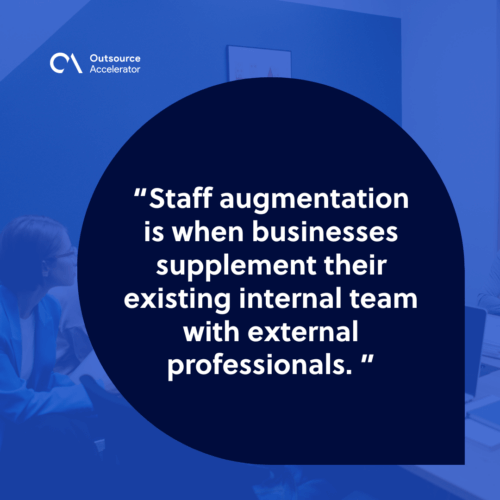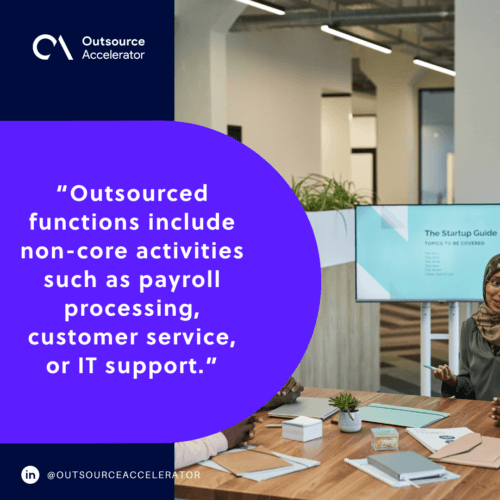Staff augmentation vs. Outsourcing: What’s best for your business?

When expanding your business and taking on new projects, the decision to pursue staff augmentation or outsourcing can be crucial. Both options offer distinct advantages and potential drawbacks, so business leaders must weigh their choices carefully.
Companies must understand the unique characteristics and implications of staff augmentation vs. outsourcing. This will help them better tailor their strategies to align with their specific goals and resource requirements.
In this article, we’ll dive into a comparison of staff augmentation and outsourcing, equipping you with the insights needed to make decisions that drive your business forward.
Staff augmentation vs. Outsourcing: Understanding staff augmentation
Staff augmentation is when businesses supplement their existing internal team with external professionals. It’s a strategic workforce management approach that can work on a temporary or project-specific basis.
Businesses assess their current workforce and identify specific skills or expertise that are lacking for a particular project or initiative. They usually work with a staffing agency to source qualified candidates, but they may also engage freelancers directly.

The augmented staff works alongside the existing team members, utilizing their skills and expertise to fill the identified skill gaps and support project completion.
This arrangement lasts for the duration of the project. Once it is over, the augmented staff members can transition to another project or leave the organization.
Benefits of staff augmentation
There are several benefits associated with staff augmentation that make it an attractive staffing solution for businesses:
Flexible resource allocation
Staff augmentation allows businesses to quickly scale their workforce up or down in response to changing project requirements or market conditions.
Companies can easily adjust the number of external resources based on their current needs. This avoids the overhead costs and administrative burden of hiring permanent employees.
Access to specialized skills and expertise
Through staff augmentation, organizations can tap into a diverse pool of talent with specific skills and experience relevant to their projects.
This access to specialized expertise enhances the quality of work, accelerates project timelines, and fosters innovation and learning within the internal team.
Cost-effectiveness
Staff augmentation eliminates the need for long-term employment contracts and benefits associated with full-time employees.
Companies can leverage external resources temporarily. They pay only for the services rendered without incurring additional expenses such as training, insurance, or equipment.
Enhanced project flexibility
With staff augmentation, businesses can easily adapt to changing project scopes, timelines, or requirements by supplementing their team with additional resources as needed.
This flexibility enables companies to meet project deadlines, address skill gaps, and handle unexpected workload fluctuations without disrupting ongoing operations.
Improved productivity and efficiency
External professionals brought in through staff augmentation are typically experienced and well-versed in their respective fields. Their expertise contributes to increased productivity and streamlined project execution.
By augmenting their workforce with skilled individuals, organizations can enhance efficiency, reduce turnaround times, and deliver high-quality results more effectively.
Reduced training and onboarding time
External staff are hired for their specific expertise and can immediately integrate into the project or team. Businesses can minimize the time and resources traditionally spent on training and onboarding new employees.
A streamlined onboarding process allows companies to maximize productivity and project output from the onset of engagement.
Challenges of staff augmentation
While staff augmentation offers numerous advantages, it also presents some challenges that businesses need to consider when implementing this staffing approach:
Integration and team dynamics
Adding external resources through staff augmentation can pose challenges in terms of integrating them into the existing team dynamics.
Establishing effective communication, coordination, and collaboration among team members, including both internal and augmented staff, may require additional effort and time.
Maintaining control and oversight
With staff augmentation, businesses need to carefully manage and monitor the work of external professionals. They’ll need to ensure alignment with project goals, quality standards, and internal processes.
Balancing the need for control and oversight while allowing augmented staff the autonomy to contribute their expertise can be a challenge.
Continuity and knowledge transfer
The temporary nature of staff augmentation can present challenges in terms of knowledge transfer and continuity.
When augmented staff members complete their engagement, there may be a loss of project-specific knowledge and insights. It thus requires careful documentation and effective handover processes.
Cultural fit and adaptability
Augmented staff may come from different backgrounds, cultures, or work environments. This can impact their ability to adapt to the company’s culture and work practices.
Ensuring cultural fit, fostering collaboration, and promoting a cohesive work environment may require extra attention and effort.
Staff augmentation vs. Outsourcing: Understanding outsourcing
In outsourcing, an organization also contracts with an external service provider. Outsourced staff performs specific business functions, tasks, and processes that were traditionally carried out internally.
Outsourced functions include non-core activities such as payroll processing, customer service, or IT support. It also extends to more specialized services like software development, marketing, or legal services.
The outsourcing arrangement typically involves a formal agreement or contract. It defines the scope of work, service levels, performance metrics, and terms of engagement between the client and the service provider.

Benefits of outsourcing
Outsourcing offers several benefits that can help businesses stay competitive, reduce costs, and improve efficiency:
Cost savings
Farming out services allow businesses to reduce operational costs by transferring certain functions to external providers.
It also eliminates the need for investments in infrastructure, technology, staffing, and training, as the service provider is delegated these responsibilities.
Service providers often operate in regions with lower labor costs, enabling significant cost savings for businesses.
Access to specialized skills and expertise
Outsourcing grants access to a global talent pool, enabling businesses to tap into specialized skills and expertise that may not be available internally.
Service providers are often equipped with experienced professionals who excel in specific areas, ensuring high-quality delivery and improved outcomes.
Working with seasoned specialists foster innovation and bring fresh perspectives into the organization.
Focus on core competencies
By outsourcing non-core functions, businesses can redirect their resources and attention to core competencies.
This strategic allocation of resources allows companies to enhance their focus on key activities, improving productivity, and driving business growth.
Increased efficiency and scalability
Outsourcing enables organizations to leverage the scalability and flexibility offered by service providers.
Businesses can easily adjust resources based on fluctuating demand, ensuring optimal operational efficiency even during peak periods or business fluctuations.
Outsourcing partners have the capabilities and infrastructure to handle varying workloads efficiently, resulting in improved productivity and reduced turnaround times.
Risk mitigation and compliance
Outsourcing allows businesses to transfer certain risks and compliance responsibilities to the service providers.
Outsourcing companies often have deep knowledge and understanding of industry regulations and compliance requirements. This approach reduces the organization’s exposure to potential risks and legal issues.
Geographical expansion and global reach
Outsourcing opens doors for businesses to expand their geographical reach and access new markets without the need for physical presence.
Service providers often have a global presence with knowledge of local markets, cultures, and customer preferences, facilitating international business operations.
Challenges of outsourcing
Outsourcing is not without its challenges, and companies need to be aware of the potential pitfalls before embarking on an outsourcing partnership:
Communication and collaboration issues
Outsourcing introduces communication challenges, especially when dealing with service providers located in different time zones or with language barriers.
Miscommunication and lack of seamless collaboration can hinder the smooth execution of outsourced tasks and projects.
Confidentiality and data security risks
Outsourcing involves sharing sensitive business data and information with external parties. This raises concerns about data security, confidentiality, and the risk of intellectual property theft.
Ensuring robust data protection measures and enforcing confidentiality agreements is crucial to mitigate these risks.
Dependency on service providers.
Businesses may become overly dependent on external service providers for critical functions. It can lead to vulnerability in case of service disruptions, disputes, or failure to meet obligations.
Loss of direct control and flexibility
Outsourcing may result in a loss of direct control over specific business functions. This makes it challenging to address immediate changes or adapt to evolving business needs without coordination with the service provider.
Staff augmentation vs. Outsourcing: Key factors to consider
When deciding whether to use staff augmentation or outsourcing, businesses should consider the following factors:
Project scope and duration
The project scope and duration may influence the choice between staff augmentation and outsourcing.
Staff augmentation is a better fit for short-term projects that require specific skills that the existing team may lack.
Outsourcing suits long-term projects that encompass multiple phases, require diverse expertise, or depend on flexible staffing.
Cost and budget
Both staff augmentation and outsourcing have cost implications that depend on factors such as location, skill levels, and market demand.
Staff augmentation can be more cost-effective when the required skills are readily available locally, while outsourcing may be cheaper for high-end skills and in countries with a lower cost of living.

In-house resource availability
If a company has a skilled workforce that can take on new tasks, staff augmentation may be the better choice.
However, if the internal team lacks the expertise, outsourcing may be the best option to ensure timely and quality project delivery.
Control and project oversight
Staff augmentation allows for more in-house control over the project. The new hires work under the same management and workflow systems.
Outsourcing may impact control, as some of the project management and communication will be handled by the external vendor.
Goals and objectives
Staff augmentation can help achieve the immediate goals of augmenting the workforce with skilled resources for a particular project.
Outsourcing can offer strategic benefits, such as a capability to expand into new markets, access to cutting-edge technology, and advanced skill sets.
Ultimately, the choice of staff augmentation vs. outsourcing requires a careful assessment of business needs, project requirements, budget constraints, and workforce availability.
A thorough evaluation of these factors can help to select the right strategy that aligns with business goals, minimizes risks, and optimizes project outcomes.







 Independent
Independent




